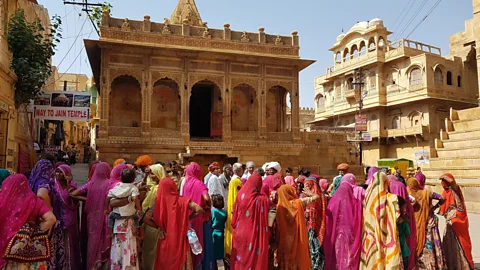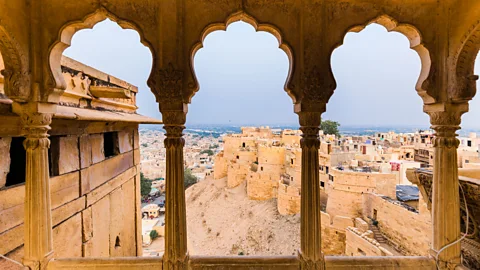"Dream, Dream, Dream! Conduct these dreams into thoughts, and then transform them into action."
- Dr. A. P. J. Abdul Kalam
"Dream, Dream, Dream! Conduct these dreams into thoughts, and then transform them into action."
- Dr. A. P. J. Abdul Kalam
16 May 2024
UnParallel Historical Significance ~
Thousands of families have called this magnificent desert stronghold in the Indian state of Rajasthan home for more than 800 years. Rising more than twenty stories from the dusty terrain like a golden sandcastle, the historic fortress of Jaisalmer is situated on the western edge of the Indian state of Rajasthan, encircled by the Thar desert. Constructed in 1156, the sandstone citadel with 99 turrets, three layers of walls, and four intimidating gates watches over a triangular hill. Jaisalmer, the Golden City, gets its name from the brilliant honey hues of the yellow sandstone used to build this fortress. Jaisalmer is a Unesco World Heritage site, along with five other magnificent forts in Rajasthan.
The citadel is more than just an important historical and architectural landmark, though, because some 2,000–4,000 descendants of the castle's original occupants still reside inside its fortified walls without paying rent because their ancestors were granted the land by local kings in exchange for their services to the kingdom more than 800 years after the castle was constructed. Not only is Jaisalmer the last inhabited historic fortress in India, but it also functions as a sort of living monument, with daily life continuing much as it did in the twelfth century among the cramped courtyards and tiny roads.

Many Hindu and Jain temples inside Jaisalmer have remained the same for centuries and are still popular
gathering places
( Photo Credit: Charukesi Ramadurai)
About Jaisalmer Fort ~
Local chieftain Rawal Jaisal, who gave the city its name, built Jaisalmer in the twelfth century. The kingdom flourished as a major station on the Silk Road commerce route, which connected Europe with China via India, Afghanistan, Turkey, and Egypt, between the 16th and 18th centuries. In search of food, drink, and a place to spend the night, caravans of Eastern traders and merchants would stop at one of Jaisalmer's tiny inns with open courtyards. Their loads included bundles of silks, valuable stones, spices, teas, and whiffs of opium. The travelers' visits brought prosperity to the local authorities, and affluent city merchants constructed havelis, or houses, as well as temples and inns both inside and outside Jaisalmer's gates.
Hundreds of years later, the only remnants of the region's importance along the Silk Road are the crumbling fortifications, stone monuments, and abandoned settlements dotting the desolate desert terrain. Nevertheless, throngs of tourists are drawn to the Golden City's numerous hotels and eateries by its winding alleyways and turreted sandstone walls. Rather than camel-riding merchants, the city is today inundated with camera-wielding visitors by the busload, but it is nevertheless a beautiful sandstone outpost where generations of people have tended to travelers for ages.
The Jaisalmer fort is now crowded with tiny tea shops and cafes, guesthouses and houses, temples and shops pressed close to one another. Locals still get money from tourists, especially those who reside inside the stronghold.Some own eateries that specialize in straightforward mezze dishes, while others market gorgeous camel leather handbags. Shop owners beckon people to come inside and look at their colorful turbans, hand-embroidered tapestries, and handicrafts.

The fortress is now a protected heritage monument and its residents are not allowed to sell their property
to an outsider or alter their facades
(Photo Credit: Patanjali Somayaji)
Nevertheless, the fortress maintains its close-knit community despite the thousands of tourists who come through here every day. Bright paintings outside many of Jaisalmer's residences proclaim impending nuptials among the castle's occupants. The names of the bride and groom are listed in the paintings, along with the wedding date, usually beneath an auspicious symbol like the elephant god Ganesha, the god of fresh beginnings.
Travelers are greeted by a meandering walk flanked by stores offering beaded handicrafts and metal jewelry as they enter the citadel through the main gate. Residents cautiously navigate up the path on their motorbikes and auto-rickshaws, honking through a sea of onlookers. The women of Jaisalmer, clad in billowing skirts and vibrant blouses, their heads veiled in vibrant dupatta scarves, bring fragrant incense sticks and fresh flowers as offerings to the temples situated within the fort. The Baa Ri Haveli, a 450-year-old home-turned-museum displaying artifacts from everyday life in the fort from the 15th Century to the present, is accessible from one of the roads up on the hillock that leads to the central Dusshera Chowk plaza.

For more than 800 years, residents inside the Jaisalmer Fort have catered to travelers journeying through
the desert
(Photo Credit: Charukesi Ramadurai)
The fort's history has been turbulent, ranging from its illustrious times as a significant Silk Road metropolis to persistent looting and invasions by foreign invaders ~ the thrill is in the air. If you ever wish to experience how living inside a gigantic historical fort feels like, this is your primary destination!